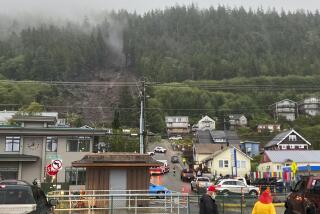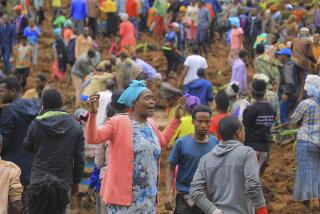In Washington state mudslide, more searching than rescuing

DARRINGTON, Wash. — Residents of this tiny town cut off by Saturday’s deadly mudslide jammed into the noisy gym, thirsting for information. The crowd buzzed, the heater clanked and the speakers’ words echoed in the cavernous space.
But Brian McMahan’s voice cut through the din: “The number of fatalities is 24,” the incident team spokesman said Wednesday night. “Late this afternoon, the crews found at least one additional body. So we’re saying the number is 25.”
Ninety minutes earlier and 28 miles west, John Pennington begged to differ. The director of the Snohomish County Department of Emergency Management said the death toll from one of Washington state’s worst disasters remained at 16.
By contrast, the number of missing and unaccounted for has fluctuated wildly, from 18 to 108 to 176 to, most recently, 90 missing, and an additional 35 who may or may not have been in the mudslide area on Saturday. Authorities have begun to fear that most, if not all, of the 90 are dead.
Part of the problem, search and rescue experts acknowledged, is the very nature of deadly disasters. Be it the Sept. 11, 2001, terrorism attack, the disappearance of Malaysia Airlines Flight 370, the Oklahoma City bombing or the killer mudslide that left a square mile of mud and debris, people want a certainty that does not exist in post-tragedy chaos. And they want it fast.
But authorities were clear Thursday that fast and certain are contradictory and impossible goals.
As he led a group of journalists around the slide site, Steve Mason, battalion chief for Snohomish County Fire District 1, said that even though the destroyed houses “looked like they were put in a blender and dropped,” they must be examined “inch by inch.”
Searchers and forensic teams spent a sixth straight day slowly combing through what Mason called “millions of cubic feet of stuff.” Officials still held out hope that a survivor could be found among the clay balls the size of ambulances.
“My heart is telling me that I’m not giving up yet,” Travis Hots, chief of Snohomish County Fire District 21, told reporters Thursday morning. “We’re going to do everything we can … even if we can just save one more person.”
The emotional toll of sifting through rubble has an impact on how information on the dead and missing is disseminated. Hope often wins out, at least initially.
As Pennington noted Wednesday night when talking about the new list of 90 missing and 35 unaccounted for, “Unless you’re in a jungle in South America, you know what’s happened here.”
But he would not release those 125 names. And he would not speculate about whether the missing were actually dead, hidden in the muck, buried in their cars, their chairs, their kitchens.
“Look at the magnitude of what happened,” he said. “The debris field is huge. It is complex. It is dangerous. And I don’t think we have a lot of answers.”
The mudslide crashed down on the tiny town of Oso, population around 200, about an hour north of Seattle. In a matter of seconds, the wall of mud destroyed 49 houses, more than half of which were occupied year-round. Structures were pancaked, and cars were torn into sharp metal shreds.
“Almost everybody we ran into that was in the accident had their clothes ripped off from the force of the accident,” first responder Jeff McClelland said. “They were naked. Even the survivors, most of them, were that. That’s just pretty horrific exposure.”
McClelland and his wife, Jan, are members of the volunteer fire department in nearby Darrington. Jan McClelland said Wednesday that while sifting through the mud and rubble this week, she came upon documents that probably had been washed out of the car of a neighbor driving on State Route 530 when the slide hit.
The McClellands suspect that they know “quite a few” of the missing and the dead. But Jan McClelland says that she “hasn’t sat down and looked at the missing list in the last day or two.”
She does not want to.
Darrington Mayor Dan Rankin, who is working to keep his town buoyed and informed, has not tallied the number of people he knows who are dead or missing. He, too, refuses to look at the list emergency workers are compiling, with its large and fluctuating number of casualties.
“That number puts a pit in my stomach,” Rankin said, tearful. “Again, like the event itself, it’s unimaginable to me.”
Kim Zagaris, fire and rescue chief at the California Office of Emergency Services, has been to every major disaster in the Golden State since 1987, and sent a 17-member team to Oso. He is “not surprised by some of the events going on,” he said. “It’s just the way disasters unfold.”
Zagaris was planning section chief in 1995 for the Oklahoma City bombing response. That disaster, he said, was the worst in terms of getting the numbers straight.
“Trying to make sure we knew everybody who was visiting and worked there … was a tough assignment,” Zagaris said from Sacramento in a telephone interview. “There was a lot of people on that list, and we had to meet with families and make sure the security of that list was maintained.”
Landslides, Zagaris and others said, are difficult disasters to live through; avalanches offer better breathing options than mud. Landslides also are deeply challenging for responders, who want to give as much benefit of the doubt to the possibility of survivors.
“With a mudslide, there is a certain amount of sensitivity that is needed for the family members,” said Robert J. Koester, a Virginia-based search-and-rescue consultant. “You don’t want to tell the families they are all buried, stick a grave marker there and walk away.”
Deaths are not declared, Koester said, until confirmed by the coroner — which has been an issue in the Oso disaster.
The medical examiner’s office has formally identified only a single victim, according to the Associated Press: Christina Jefferds, 45, of Arlington. The medical examiner determined that she was killed by accidental blunt impact. But the Jefferds family says her infant granddaughter has also been found, just 10 feet from Jefferds’ body.
Hots said at a news conference Thursday morning that rescuers were not releasing the numbers of the dead or any new information about them. That, he said, is being left to the medical examiner.
Recovering a body can take hours after discovery, he said, adding that one victim had apparently been driving on State Route 530 before the slide smashed into the car. The vehicle was dragged 200 feet. Rescuers had to remove the roof to extract the driver’s remains.
“Once the person is removed, it gets kind of somber out there,” Hots said. “You can hear a pin drop. You get seasoned veterans who tear up. It’s our way of paying respect.”
molly.hennessy-fiske@latimes.com
La Ganga and Hennessy-Fiske reported from Washington state, Dave from Los Angeles. Matt Pearce in Los Angeles contributed to this report.
More to Read
Sign up for Essential California
The most important California stories and recommendations in your inbox every morning.
You may occasionally receive promotional content from the Los Angeles Times.













